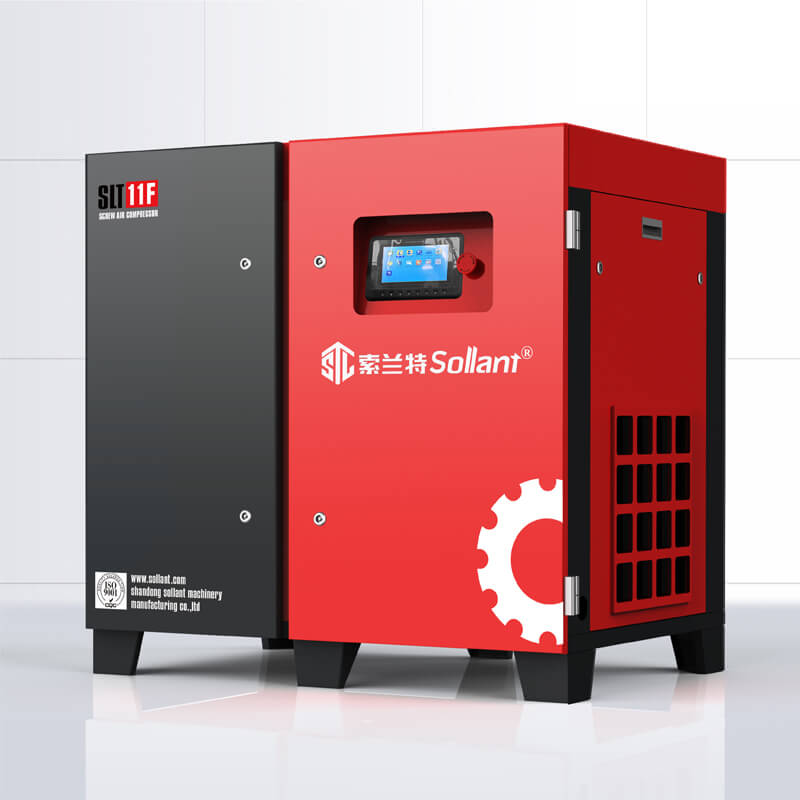In-depth analysis of screw air compressor transmission mode

In the transmission system of the air compressor, it can generally be divided into direct drive and belt drive. The direct drive of the screw air compressor refers to the fact that the motor shaft drives the rotor through the transmission of the coupling and the gear box, which is not actually a direct drive in the true sense. True direct drive means that the motor is directly connected to the rotor (coaxial) and both speeds are the same. This situation is obviously very rare. So the view that there is no energy loss in direct drive is wrong.
Another transmission method is the belt drive, which allows the rotation speed of the rotor to be changed through pulleys of different diameters. The belt drive system discussed below refers to an automation system representing the latest technology that meets the following conditions:
● The belt tension of each running state reaches the optimal value.
● By avoiding excessive starting tension, the life of the belt is greatly extended, and the load on the motor and rotor bearings is reduced at the same time.
● Always ensure correct pulley connection.
● It is very easy and fast to replace the belt, and it is not necessary to adjust the original setting.
● The entire belt drive system operates safely and without failure.
It is worth mentioning that manufacturers who advocate direct gear transmission also have some products that use belt transmission.
Comparison of gear drive and belt drive
1. Efficiency
Excellent gear transmission efficiency can reach 98%-99%, and excellent belt drive design can also achieve 99% efficiency under normal conditions (see the research report published by Professor HeinzPeeken on “Transmission Technology” in December 1991). The difference between the two does not depend on the choice of transmission mode, but on the design and manufacturing level of the manufacturer.
2. No-load energy consumption
For gear direct transmission, the no-load pressure should generally be maintained above 2.5bar, and some even as high as 4bar, to ensure the lubrication of the gearbox. For the belt drive mode, theoretically speaking, the no-load pressure can be zero, because the oil sucked by the rotor is enough to lubricate the rotor and the bearing. Generally, for safety reasons, the pressure is maintained at about 0.5 bar.
Take a 160kw gear-driven air compressor as an example, 8000 hours per year, 15% (1200 hours) of which is no-load, this machine will consume 28800kwh more electricity than the belt-driven air compressor of the same power every year (Assuming that the no-load pressure difference between the two machines is 2bar, the energy consumption difference is about 15%), in the long run, this will be a big expense.
3. Oil loss
Experienced practical users know that the gearbox will be the first to suffer in the event of oil loss. Belt drive systems do not have this safety issue at all.
4. Design pressure according to user requirements
Usually the pressure required by the user is not completely consistent with the pressure of the manufacturer’s standard model. For example, the user requires a pressure of 10 bar. Depending on the condition of the post-processing equipment, the length of the piping and the degree of sealing, the required pressure of the air compressor may be 11 or 11.5 bar. In this case, an air compressor with a rated pressure of 13bar is generally installed and the outlet pressure is set to the required pressure on site. At this point the displacement will remain essentially the same because the final pressure has decreased but the speed of the rotor has not increased.
The belt drive design and manufacturer representing modern technology only need to simply change the diameter of the pulley and design the pressure to be completely consistent with the user’s requirements, so that the user can obtain more air volume with the same power motor. For gear transmission, it is not so convenient.
5. The pressure change of the installed air compressor
Sometimes due to changes in the user’s production process conditions, the design pressure of the original air compressor may be too high or too low, and it is hoped to be changed, but for gear-driven air compressors, this will be very difficult and expensive, while for Belt-driven air compressors are a breeze, just replace the pulley.
6. Install new bearings
When the rotor bearing needs to be replaced, for the gear-driven air compressor, the gearbox and the gearbox main shaft bearing need to be overhauled at the same time, and the cost is unacceptable to the user. For belt drive air compressors, there is no such problem at all.
7. Replace the shaft seal
Any screw air compressor uses an annular shaft seal, which needs to be replaced after a certain lifespan. For gear-driven air compressors, the motor and coupling must be separated before access to the shaft seal, which makes this time-consuming and labor-intensive, resulting in increased maintenance costs. For belt drive air compressors, it is much easier to just remove the pulley first.
8. Motor or rotor bearing damage
For gear transmission air compressors, when the motor or rotor bearing is damaged, it will often affect the connected important components and cause direct and indirect double damage. This situation does not exist for belt drive air compressors.
9. Structure noise
For gear transmission air compressors, since the motor is rigidly connected to the rotor, the vibration of the rotor in the compression chamber will be transmitted to the gearbox and motor bearings, which not only increases the wear of the motor bearings, but also increases the noise of the machine.
Sollant Group-Professional Compressed Gas Solutions Provider



